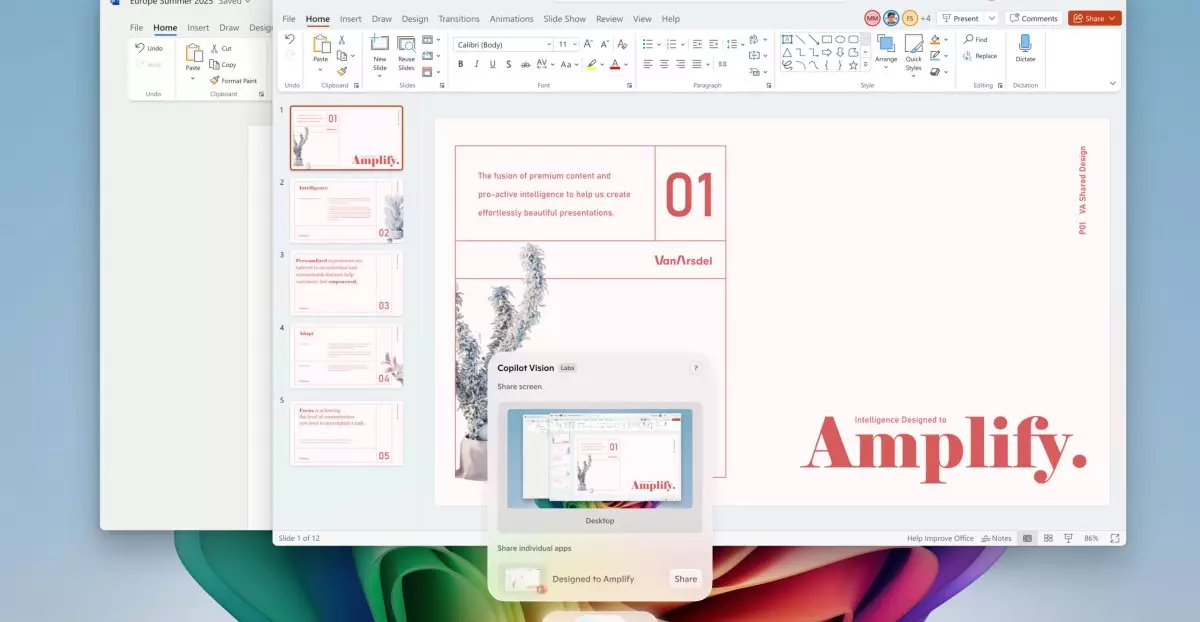Microsoft’s latest push into AI integration signifies a bold leap toward transforming how users interact with their Windows 11 devices. The introduction of the Copilot Vision tool, which enables real-time screen analysis, signals a new era of intelligent computing. Unlike traditional software updates, this feature leverages advanced AI to interpret the entire visual landscape of a user’s desktop, ushering in an era where machines understand context as humans do. This innovation isn’t just about convenience; it reshapes the very concept of user-device collaboration by making screens smarter and more responsive.
This development demonstrates Microsoft’s strategic focus on blending AI seamlessly into everyday tasks—moving beyond mere automation to true enhancement. By allowing users to ask questions about their screen content or get task-specific assistance through natural language, the Copilot Vision turns a static visual landscape into an interactive knowledge base. It’s a step forward from straightforward commands, ushering in an era where your PC can understand and respond to complex intentions without rigid menus or convoluted steps.
However, the ambition here is not without its flaws. While the promise of AI that comprehends multiple apps and web pages simultaneously is impressive, it raises questions about privacy, data security, and reliance. The more that AI is embedded in our screens, the more vulnerable we become to potential breaches or misuse. Microsoft must balance innovation with responsibility, ensuring these powerful tools do not compromise user data or lead to unintended consequences.
Exclusive Power for the Select Few: The Premium Experience
Microsoft’s strategy to restrict some of these features—including the highly anticipated AI agent, advanced “Click to Do” functionalities, and enhanced editing tools—to premium “Copilot Plus” PCs hints at a broader industry trend: the commercialization of AI as a premium service. While existing Windows 11 users can access basic AI tools, the most sophisticated capabilities are being reserved for high-end devices, effectively creating a two-tiered ecosystem.
This approach, although commercially prudent, risks alienating average users who could benefit from these innovations but are priced out. It underscores a growing disparity in tech access—where artificial intelligence becomes a luxury rather than a standard feature. Moreover, by tying these advanced features to Snapdragon-powered hardware, Microsoft’s ecosystem begins to resemble a walled garden, where premium performance and exclusivity are intertwined.
From a critical perspective, this stratification could deepen the digital divide. True innovation should ideally be democratized, accessible across all spectrums of hardware and user needs. Microsoft’s current strategy, while lucrative, may inadvertently slow this democratization, fostering frustration among those who see AI as the future but cannot afford the latest devices.
Transformative Tools for Content Creation and Management
One of the most exciting aspects of Microsoft’s AI overhaul is the suite of tools designed to empower content creators and professionals. The new AI-powered “sticker generator” in Paint, the object selection feature, and AI lighting adjustments in Photos showcase an emphasis on creative productivity. These enhancements promise to lower barriers for users who want professional-level editing and design without extensive training or expensive software.
More striking is the integration of AI with familiar productivity workflows, such as drafting documents in Word or scheduling meetings in Teams. These features reflect a broader trend: AI as a true co-worker, capable of handling complex tasks that traditionally required human intervention. It signifies a shift toward hybrid human-AI collaboration, where machines handle routine or time-consuming chores, freeing humans for higher-level thinking.
But here’s where a healthy dose of skepticism must come in. Relying heavily on AI for creative and organizational tasks raises concerns about originality, authenticity, and skill degradation. Will future users lose their ability to produce or think critically if their primary tools become overly automated? Microsoft must be cautious to ensure that AI enhances rather than diminishes human capability.
The Road Ahead: Innovation Versus Overreach
The rapid rollout of these AI features shows Microsoft’s push to position Windows 11 as a cutting-edge platform. Yet, rapid innovation often invites scrutiny. As these AI capabilities become more deeply embedded into the operating system, issues around reliability, user control, and ethical considerations will inevitably arise.
While some features like the color picker or auto-fix mechanisms offer tangible benefits, others—like the “perfect screenshot” AI within the Snipping Tool—push the boundaries of what privacy and convenience should entail. The risk is that these tools could inadvertently lead users to overshare or over-rely on AI, diminishing personal engagement and oversight.
Furthermore, the strategic focus on high-end hardware might restrict accessibility, delaying the universal benefits of AI-powered Windows 11. Instead of a broad democratization of intelligent tools, Microsoft seems content to lead a segment of power users into the future, potentially widening the chasm between tech haves and have-nots.
In sum, Microsoft’s AI ambitions for Windows 11 are undoubtedly revolutionary, pushing the boundaries of what personal computing can achieve. Yet, with power comes responsibility. How the company manages privacy, access disparities, and ethical concerns will determine whether this technological leap becomes a true boon for users or a double-edged sword.

